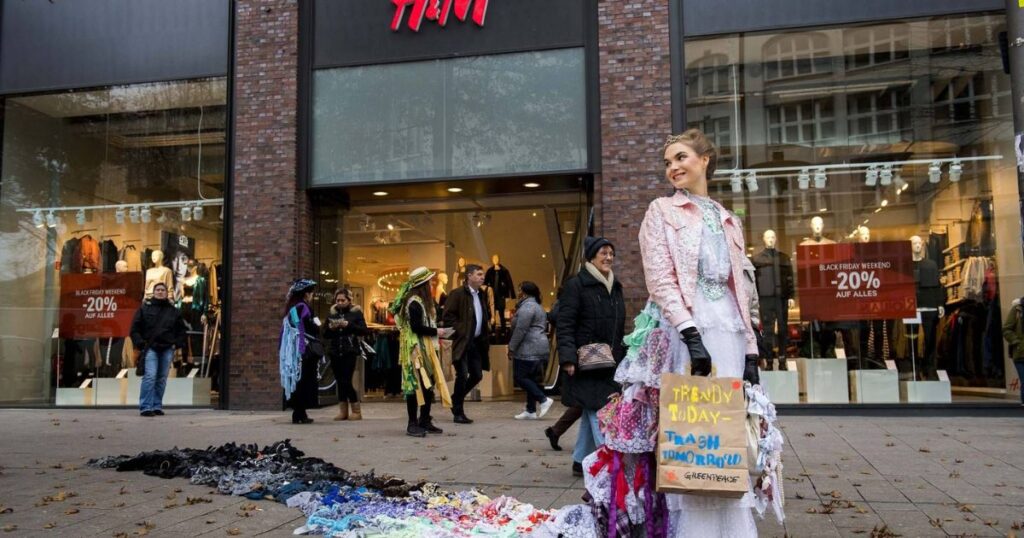Eco-Stylist operates with the support of our readers. By utilizing the links provided, you can contribute to our mission, and we may earn a commission. We showcase fashion brands that align with our stringent sustainability standards. Discover more details here.
Mindfulness, community, sustainability. Lululemon, a Canadian sportswear retailer, has meticulously crafted its brand to evoke these values. They profess a dedication to catalyzing meaningful global change, emphasizing their two-decade-long commitment to community empowerment and their ongoing journey to address social and environmental challenges. While these assertions may suggest a genuine commitment to ethics and sustainability, the extent of their dedication is less transparent than their website suggests.
Let’s delve into the pertinent inquiries surrounding whether Lululemon qualifies as a fast fashion entity, and examine their sustainability and ethical practices. Additionally, we’ll scrutinize some of the controversies that have surrounded them in recent years.
What is Lululemon?
Lululemon, originally established in 1998 as a yoga apparel retailer, has evolved into a prominent athleisure brand over the years. While its offerings now extend beyond yoga wear to include sports gear, loungewear, and accessories, the brand’s journey hasn’t been without controversy.
Founder Chip Wilson’s candid admission about the origin of the company’s name, chosen for its perceived difficulty for Japanese customers to pronounce, has sparked criticism. This acknowledgment of cultural insensitivity seems incongruent with the brand’s purported commitment to community and wellness, potentially challenging the credibility of its other values and assertions.
Is Lululemon Fast Fashion?

Initially, this prominent activewear brand might not seem synonymous with fast fashion, as it concentrates on activewear rather than adhering to the broad, swiftly evolving trends typically linked with fast fashion.
Nonetheless, they churn out garments rapidly and in large quantities, frequently updating their website with fresh stock. Consequently, they warrant recognition as a significant contributor to the fast fashion dilemma.
Also read this Post: ARITZIA FAST FASHION
Key points detailing the differences between Lululemon and fast fashion:
Quality
Lululemon: Embraces high-quality materials crafted for durability and performance, ensuring longevity.
Fast Fashion: Typically opts for lower-quality materials, resulting in products with a shorter lifespan.
Price Point
Lululemon: Presents products with a higher price tag, mirroring their quality, durability, and ethical production practices.
Fast Fashion: Generally offers lower prices, sacrificing quality and ethical production in favor of accessibility.
Production Ethics
Lululemon: Maintains ethical production practices and is increasingly prioritizing sustainability.
Fast Fashion: Often criticized for questionable labor practices and significant environmental impacts.
Fashion Cycle
Lululemon: Concentrates on crafting timeless pieces that transcend fleeting trends.
Fast Fashion: Known for rapid style turnover to match current trends, prompting frequent purchases.
Community Engagement
Lululemon: Actively fosters community through events, workshops, and online interaction.
Fast Fashion: Typically lacks focus on community-building or extensive customer engagement beyond sales.
Sustainability
Lululemon: Enhancing efforts in utilizing sustainable materials and eco-friendly practices.
Fast Fashion: Frequently falls short in sustainable practices, contributing more to environmental harm.
Consumer Relationship
Lululemon: Aims to cultivate a lifestyle and enduring bond with consumers, extending beyond mere product sales.
Fast Fashion: Primarily focuses on immediate sales, with less emphasis on fostering customer loyalty or a lifestyle brand.
These points underscore the profound differences between Lululemon’s fashion approach and the conventional fast fashion model, highlighting Lululemon’s dedication to quality, sustainability, and community engagement.
The Fast Fashion Enigma
Understanding Lululemon necessitates comprehending ‘fast fashion’ — a term resonating ominously within the fashion realm.
Fast fashion entails mass-producing inexpensive, trendy clothing mirroring runway styles at a fraction of the cost.
While economically appealing, this approach often entails environmental repercussions, dubious labor practices, and a culture of disposability.
Lululemon’s Ballet: Prioritizing Quality
Lululemon diverges from the fast fashion ethos by prioritizing quality. A Lululemon piece, whether a yoga pant or running jacket, is more than just attire; it’s a companion on one’s journey to self-improvement.
The brand emphasizes quality, durability, and functionality, each piece designed to endure and withstand the test of time and practice. This philosophy inherently contradicts the fast fashion model of ‘wear it today, discard it tomorrow.’
The Emotional Spectrum of Lululemon
Delving into Lululemon’s essence unveils an emotional connection.
There’s a sense of community, forged in yoga studios and running tracks, and a shared aspiration for self-improvement.
Wearing Lululemon isn’t just about the garments; it’s about belonging to a tribe valuing health, mindfulness, and balanced living.
Sustainability and Mindful Creation
In recent years, Lululemon has made strides in sustainability, recognizing the inseparable link between fashion and the planet’s future.
They’ve begun integrating more sustainable materials and practices, acknowledging ongoing room for growth and improvement in this crucial area.
Beyond the Price Tag
Indeed, Lululemon’s products command a higher price, a stark departure from fast fashion’s budget-friendly allure.
However, this cost mirrors a commitment to quality and ethical production practices.
It’s an investment not only in clothing but also in a philosophy and a community.
What is Lululemon’s Environmental Impact?

In prior times, lululemon has faced scrutiny from both activists and customers over allegations of false advertising. They’ve been accused of portraying themselves as an environmentally sustainable brand despite practices that don’t always align with these claims.
The company has set numerous science-based targets, meticulously documented in their annual impact reports. However, these reports indicate that lululemon is falling short on several key objectives, notably in the pursuit of preferred materials for all their merchandise.
With a 2030 deadline looming for the bulk of these targets, the pressure is mounting for them to bridge the gap.
How Transparent is Lululemon?
Lululemon earned a 52% score in the 2023 Fashion Transparency Index, outperforming some rivals but still falling short overall. They excelled in policy transparency, achieving an 87% rating. This reflects their commitment to sharing environmental and social objectives, notably through comprehensive yearly impact reports. Such transparency sets them apart from typical fast fashion brands.
However, their performance in supply chain traceability and addressing key issues is less impressive, with scores of 53% and 40% respectively. This suggests that while they set public goals, they’re less forthcoming about their strategies for achieving them. Crucial data, such as wage information, efforts to curb overconsumption and waste, and plans to reduce their water footprint, remains undisclosed.
What Materials is Lululemon Using?
While Lululemon’s yoga mats incorporate over 85% natural rubber, which may be seen as preferable to synthetic alternatives used by competitors, it’s not without drawbacks. The production of natural rubber can contribute to deforestation and biodiversity concerns, and it’s often blended with less eco-friendly chemical components.
Additionally, their popular sports leggings and tops, like much of their clothing line, are primarily composed of non-biodegradable nylon and lycra, both of which emit greenhouse gases harmful to the environment.
Is Lululemon Carbon Neutral?
In the summer of 2023, a group of 129 athletes penned an open letter to the company, urging them to commit to transitioning from fossil fuels to 100% renewable energy sources. Their call came in response to the revelation that the retailer’s carbon footprint had surged by a staggering 60% compared to the previous year.
In their 2022 impact report, lululemon expressed their commitment to becoming a net-zero company. They highlighted efforts to embed this goal across their supply chain, with just over half of their key suppliers reported to be actively pursuing carbon reduction strategies by 2022.
While these efforts mark a positive step forward, there remains much more ground to cover.
Is Lululemon Ethical?

Who is Making Their Clothes and Where are They Being Made?
Lululemon releases a biannual roster of their suppliers and subcontractors, detailing key information about the manufacturing facilities where their garments are made, including their whereabouts, workforce size, and gender demographics.
While this demonstrates a commendable commitment to supply chain transparency, the company has faced scrutiny for not taking sufficient steps to safeguard the well-being of its employees.
Labour Conditions
Lululemon, a member of the Fair Labor Association, pledges to protect workers and ensure fair pay for those who make their products. They claim to verify that all makers in their suppliers’ facilities receive at least the legal minimum wage for regular work and overtime. However, this assurance is not as reassuring as it may seem.
Essentially, Lululemon is only guaranteeing that suppliers uphold local minimum wage laws and pay workers on time, which is a very basic standard. What’s more concerning is that paying a ‘legal’ wage does not necessarily mean workers are earning a living wage. This is particularly troubling given that Lululemon relies heavily on subcontracted labor from countries with poor workers’ rights records, such as Vietnam, the Philippines, and China.
Additionally, in 2021, Lululemon was implicated, along with other companies, in having ties to suppliers that used cotton from Xinjiang, China, where forced labor and human rights abuses are prevalent.
Is Lululemon Vegan and Cruelty-free?
No, they do not qualify as cruelty-free or vegan. Despite their avoidance of certain materials like fur or leather, they have not pledged to embrace veganism or cruelty-free practices going forward. Additionally, their use of uncertified wool, coupled with their statement about transitioning to non-mulesed wool, suggests a lack of certainty regarding their commitment to animal welfare.
To Summarise… Is Lululemon Sustainable?
Lululemon positions itself as a beacon of sustainability, emphasizing eco-conscious practices in their production process and crafting durable activewear meant to stand the test of time. While they demonstrate a higher level of transparency compared to some fast fashion counterparts, their efforts still fall short of substantial impact. Despite setting targets and engaging in initiatives, the gap between rhetoric and action remains wide.
Their claims of sustainability verge on exaggeration, leading to accusations of greenwashing. While they present themselves as stewards of the environment, the reality may not align. Consumers seeking truly ethical and eco-friendly options can find alternatives that better fulfill these criteria.
The company must shift focus from mere rhetoric to tangible action. This entails sourcing sustainable materials, reducing greenhouse gas emissions, ensuring worker welfare, and upholding fair wages throughout their operations and supply chain.
Sustainable Alternatives to Lululemon

There are many great, eco-friendly, ethical, and affordable athletic fashion brands out there for you to discover. Here are just a few we’ve picked out for you.
Girlfriend Collective
Girlfriend Collective is a brand dedicated to promoting body positivity while also prioritizing ethical and environmentally responsible practices in their clothing production. They use recycled materials like fabric scraps, plastic bottles, and old fishing nets for both their packaging and clothing items, demonstrating their commitment to sustainability. Their focus on eco-friendly operations underscores their dedication to minimizing their environmental footprint.
Iron Roots
Iron Roots excels in crafting sustainable athletic apparel. Their emphasis on being entirely plastic-free is commendable. Instead, they opt for wholly natural materials like hemp and eucalyptus. Moreover, the company actively participates in initiatives like The Ocean Cleanup, showcasing a genuine dedication to effecting positive change.
Groceries Apparel
This brand employs organic, recycled materials in crafting sustainable activewear that instills a sense of pride. Groceries Apparel takes charge of all production stages to guarantee ethical and sustainable manufacturing practices for their clothing line.
Looking for More Ethical, Environmentally Friendly Brands
With over a hundred meticulously researched and rated brands, Eco-stylist ensures they’re championing both the planet and its people. Feel good about looking good—explore our shop today and start dressing with purpose.







